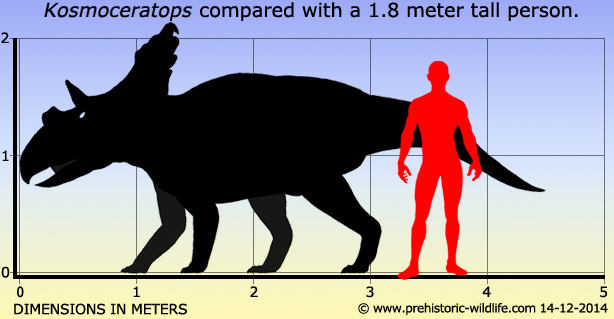In Depth
Named in 2010, Kosmoceratops has quickly become a dinosaur fan favourite, thanks largely to the highly ornate form of the skull, which was also the inspiration for the genus name. To start, the frill section of the skull is twice as wide as it is long, which by physical proportions, means that it is among the shortest known frills for a chasmosaurine ceratopsian dinosaur. At the top of the frill there are ten small horns, the central eight of which curve down and towards the braincase, while the two horns on the end project to the sides. The nasal horn is low and laterally compressed so that it forms more of a blade like structure, and in the holotype is noted as having a blunt tip. Perhaps most interesting though are the brow horns that grow from above the eye sockets. Usually, ceratopsians that have brow horns are noted as curving either forwards or backwards, but in Kosmoceratops the horns actually project out to the sides, and Kosmoceratops is a rare example of this. Altogether this is yet further evidence that the horns and frills of ceratopsian dinosaurs were more for species recognition and display rather than defence.
The reason for the highly ornate form of Kosmoceratops seems to have been a result from living in a restricted habitat. Not long after the chasmosaurine ceratopsians appeared in Laramidia, they seem to have become isolated in northern and southern populations due to geological barriers in central Laramidia. It was not until these barriers disappeared later in the Cretaceous that northern and southern populations mixed. Before this time, limited gene pools within the restricted populations would have allowed for a greater chance of elaborate skull designs than that typically seen in larger populations that usually ‘water down’ the appearance of unique physical characteristics.
Kosmoceratops is known to have shared it’s habitat with another chasmosaurine ceratopsian named Utahceratops, while a slightly more distantly related centrosaurine ceratopsian called Nasutoceratops is also present. Hadrosaurs such as Parasaurolophus and Gryposaurus are also present, while the main predatory threats to Kosmoceratops would include tyrannosaurs such as Teratophoneus and when younger troodonts such as Talos.
Further Reading
- New horned dinosaurs from Utah provide evidence for intracontinental dinosaur endemism. - PLoS One 5(9):e12292 . - S. D. Sampson, M. A. Loewen, A. A. Farke, E. M. Roberts, C. A. Forster, J. A. Smith & A. L. Titus - 2010.










